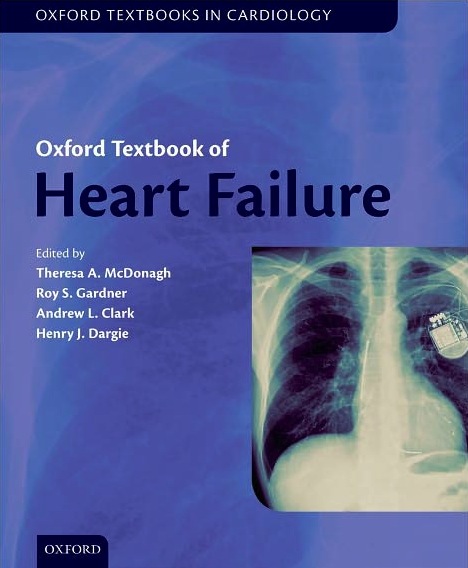Oxford textbook of heart failure
Editors: McDonagh TA, Gardner RS, Clark AL, Dargie HJ
Publisher: Oxford University Press, Oxford, 2011
ISBN: 978-0-19-957772-9
Price: £110.00
 It is predicted that the prevalence of heart failure will continue to rise as more people survive cardiac conditions that not too long ago were deemed fatal, and as clinicians get better at recognising and diagnosing it.
It is predicted that the prevalence of heart failure will continue to rise as more people survive cardiac conditions that not too long ago were deemed fatal, and as clinicians get better at recognising and diagnosing it.
This compendium, which has been compiled by experts in the field, serves as an essential reference for anyone who is serious about the topic of heart failure. It provides the information required in a piecemeal fashion without compromising on crucial detail and evidence base, sometimes lacking in other textbooks attempting to condense this broad subject matter.
It is presented in an easy to read and uncluttered fashion and there are adequate illustrations, tables, graphs and flow charts that explain abstract areas and buttress home points throughout the text. The arrangement and headings of the chapters also ensure a seamless and logical flow of information.
McDonagh et al. have commendably dedicated 11 of the 57 chapters to co-morbidities in heart failure, focusing on conditions that clinicians will normally see in a real life heart failure cohort. This is very helpful not only to the expert cardiologist, but for any other health care professional who is involved in the day-to-day management of this complex syndrome. One interesting chapter covers sleep disordered breathing, which is fast gaining ground as a potential, prognostically important treatment target.
The chapters on epidemiology and pathophysiology particularly provide very important background information that is necessary for healthcare professionals who manage this condition. Two excellent chapters give guidance on heart failure with preserved ejection fraction and right heart failure, and a robust evidence base forms the foundation of latter chapters that look at the current and future therapies for heart failure. An independent chapter on cardiomyopathies would have been welcome, but this is a small point.
Overall this book succeeds in covering a wide spectrum of topics from pathophysiology to management while providing practical guidance along the way. It is difficult to find any major faults and, while there are small omissions, it certainly fulfils its mandate as a thorough reference text for the management of heart failure.
Henry Oluwasefunmi Savage
Specialist Registrar in Cardiology
Royal Brompton Hospital, London
Our speaker today: a guide to effective lecturing
Author: Allan Gaw
Publisher: SA Press, 2011
ISBN: 978-0956324214
Price: £12.99
 For a few moments as I came to the end of Dr Gaw’s very good book I had a vision that if every speaker and lecturer in the world was forced to read it and act on its contents, what would the result be? Every talk would be well prepared, relevant to the audience and just the right length, as suggested by the author’s comment: “When someone asks me how they should finish their talk I say, ‘on time’”.
For a few moments as I came to the end of Dr Gaw’s very good book I had a vision that if every speaker and lecturer in the world was forced to read it and act on its contents, what would the result be? Every talk would be well prepared, relevant to the audience and just the right length, as suggested by the author’s comment: “When someone asks me how they should finish their talk I say, ‘on time’”.
Every slide would be clear, simple, easy to read at a distance and if it contained Kaplan-Meier curves or complicated tables would always be redrawn to fit the presentation rather than being pasted in out of a journal. Every visual aid would be explained, and no speaker would ever say ‘This is a rather busy slide’.
Questions would be asked and answered courteously and add to our understanding, and the chair of the meeting would introduce the speaker succinctly with an encouraging smile, then clamp down quickly on troublemakers whose questions were thinly veiled attempts at self-publicity or just showing off.
Of course, this vision of a utopian medical meeting is unlikely ever to come to pass. If it does, Dr Gaw can take some credit for helping to bring it about. The author has been presenting and lecturing for more than 25 years and, as he admits himself, has seen many examples of how it should not be done. The book is full of practical advice for the nervous and the novice, written in a relaxed conversational style laced with amusing anecdotes. My own favourite is the professor at medical school whose only preparation was to ask the students at the start of his lecture, “What year are you on?”.
The lasting impression is of a man with a passion for presenting who wants to pass on not just tips and tricks but also his own enthusiasm for the subject. It’s a good, easy read and will be an invaluable help to speakers who are just breaking into the speaking routine. As Dr Gaw says, all speakers have a responsibility to be good – a few will become great. This book is a welcome rung on the ladder.
John Clare
Chief Executive of LionsDen Communications
